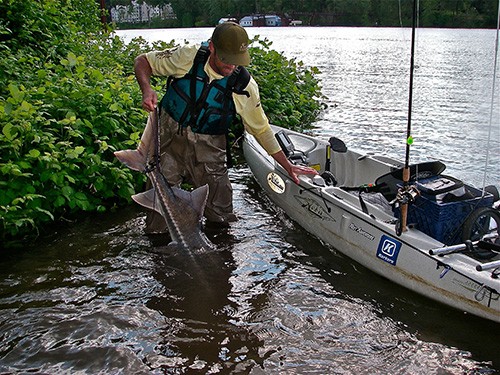Sturgeon are rather abundant in the Pacific Northwest and can easily grow over 10 feet in length and weigh over 1000 pounds. Targeting these river monsters from a Hobie kayak is not only a rush of adrenaline, but can be a serious workout as well. White sturgeon are primarily bottom feeders and spend most of their life searching for food in the ocean and fresh water rivers. Targeting these massive fish along the Columbia River and its many tributaries isn’t tough, you just need to understand what these fish are eating. Sturgeon have a very keen sense of smell and will travel multiple miles upriver in search of a potential meal from a single scent trail.

The bait is a very important factor in hooking these ancient beasts. One of the more effective baits that I have success with is squid. You can find this bait in the freezer at most local fishing stores or also in Asian markets. A few other options that produce great results are herring, anchovy, shad, tuna belly, salmon eggs, or anything that’s high in flavor, scent and oil.
The rods I typically have the best success with are 8’ boat rods, similar to a Daiwa Proteus rod with MH power and fast action. Sturgeon large or small have a soft bite and you never really know what you’re hooking into until you first set the hook. A soft tip is important so you can feel the light bites of a sturgeon, but you’ll need the backbone of a sturdy rod for a massive fish.

For the reel I run a level wind like a Daiwa Sealine. When reeling up a sturgeon, it’s important to have a quality reel that won’t slip, strip, or skip. These fish can put some serious pressure on your equipment, so having a quality setup is important. Sturgeon only want to get straight back down to the bottom, so get comfortable and get ready for a tug-of-war.
For the line I always run an 80# braid that will hold up to a sturgeon’s razor-sharp scutes (hard razor sharp scales along the lateral line). Sturgeon like to roll up the line and having a heavier braid will help keep the scutes from cutting the line. Between the main line and 7/0 barbless circle hooks, I run a 3-4 foot section of 72# Dacron line. Because Sturgeon don’t have teeth like other fish, they use their long snout or lips that pick the food up, inspect it by nibbling on it and then attempt to swallow. Dacron line in important because it’s a thick silky line, that isn’t as noticeable on their lips like mono. They will lightly chew on your bait for a couple seconds prior to committing to swallow, so it’s important to have a soft Dacron leader attached to the bait.
An Anchor Trolley is important because it allows you to face either upstream or downstream while on anchor. I usually prefer to face downstream. This allows me to detach straight into a sleigh ride when the big ones bite.